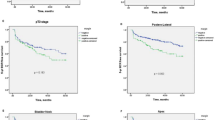Abstract
Discovery of macroscopically positive lymph nodes (LN) during radical prostatectomy for clinically localized prostate cancer (PCa) is a rare event. We describe our experience of intraoperative finding of grossly positive LN during radical prostatectomy and evaluate outcomes and predictors. A total of 4,480 patients underwent robot-assisted radical prostatectomy (RARP) for clinically localized PCa from 2001 to 2010, and pelvic LN dissection was performed in 4,090 of these patients (91.3%). Patients with macroscopically positive LN discovered and confirmed intraoperatively were assessed, as was surgical decision (abort versus continue RARP). Patients with macroscopic LN-positive disease were also evaluated and oncologic outcomes were compared with patients with microscopic LN-positive disease on final pathology. LN-positive disease was found at final pathology in 87 patients (2.1%), of whom 13 (14.9%) had grossly abnormal LN confirmed intraoperatively by frozen section. RARP was aborted in nine cases and completed in four patients. All patients received adjuvant therapy with hormonal deprivation and/or radiation. Two patients in the aborted RARP subset died of PCa. All patients who underwent completion RARP are still alive at a mean follow-up of 57.2 months with one patient still alive at 95 months. Patients with macroscopically positive LN had a higher median preoperative prostate serum antigen (PSA) (17.2 vs. 6.7 μg/L, P = 0.002) and were more likely have biopsy perineural invasion (77.8 vs. 32.4%, P = 0.012). Intraoperative findings of macroscopically positive LN during RARP is a rare event that may occur in high-risk patients, particularly in those with a high PSA and biopsy perineural invasion. Long-term survival is possible after completion RARP.
Similar content being viewed by others
References
Heidenreich A, Aus G, Bolla M et al (2008) EAU guidelines on prostate cancer. Eur Urol 53:68–80
Dahm P, Yeung LL, Chang SS, Cookson MS (2008) A critical review of clinical practice guidelines for the management of clinically localized prostate cancer. J Urol 180:451–459 Discussion 460
Walz J, Gallina A, Saad F et al (2007) A nomogram predicting 10-year life expectancy in candidates for radical prostatectomy or radiotherapy for prostate cancer. J Clin Oncol 25:3576–3581
Walsh PC, DeWeese TL, Eisenberger MA (2007) Clinical practice. Localized prostate cancer. N Engl J Med 357:2696–2705
Hsu CY, Joniau S, Oyen R, Roskams T, Van Poppel H (2007) Outcome of surgery for clinical unilateral T3a prostate cancer: a single-institution experience. Eur Urol 51:121–128 Discussion 128–129
Freedland SJ, Partin AW, Humphreys EB, Mangold LA, Walsh PC (2007) Radical prostatectomy for clinical stage T3a disease. Cancer 109:1273–1278
Schroder FH, Kurth KH, Fossa SD et al (2004) Early versus delayed endocrine treatment of pN1–3 M0 prostate cancer without local treatment of the primary tumor: results of European organisation for the research and treatment of cancer 30846–a phase III study. J Urol 172:923–927
Engel J, Bastian PJ, Baur H et al (2010) Survival benefit of radical prostatectomy in lymph node-positive patients with prostate cancer. Eur Urol 57:754–761
Ghavamian R, Bergstralh EJ, Blute ML, Slezak J, Zincke H (1999) Radical retropubic prostatectomy plus orchiectomy versus orchiectomy alone for pTxN+prostate cancer: a matched comparison. J Urol 161:1223–1227 (discussion 1227–1228)
Menon M, Tewari A, Baize B, Guillonneau B, Vallancien G (2002) Prospective comparison of radical retropubic prostatectomy and robot-assisted anatomic prostatectomy: the Vattikuti Urology Institute experience. Urology 60:864–868
Menon M, Tewari A, Peabody J (2003) Vattikuti Institute prostatectomy: technique. J Urol 169:2289–2292
Menon M, Shrivastava A, Kaul S et al (2007) Vattikuti Institute prostatectomy: contemporary technique and analysis of results. Eur Urol 51:648–657 Discussion 657–648
Tewari A, Issa M, El-Galley R et al (2001) Genetic adaptive neural network to predict biochemical failure after radical prostatectomy: a multi-institutional study. Mol Urol 5:163–169
Stamey TA, Yemoto CM, McNeal JE, Sigal BM, Johnstone IM (2000) Prostate cancer is highly predictable: a prognostic equation based on all morphological variables in radical prostatectomy specimens. J Urol 163:1155–1160
Cheng L, Zincke H, Blute ML, Bergstralh EJ, Scherer B, Bostwick DG (2001) Risk of prostate carcinoma death in patients with lymph node metastasis. Cancer 91:66–73
Schumacher MC, Burkhard FC, Thalmann GN, Fleischmann A, Studer UE (2008) Good outcome for patients with few lymph node metastases after radical retropubic prostatectomy. Eur Urol 54:344–352
Daneshmand S, Quek ML, Stein JP et al (2004) Prognosis of patients with lymph node positive prostate cancer following radical prostatectomy: long-term results. J Urol 172:2252–2255
Fleischmann A, Schobinger S, Schumacher M, Thalmann GN, Studer UE (2009) Survival in surgically treated, nodal positive prostate cancer patients is predicted by histopathological characteristics of the primary tumor and its lymph node metastases. Prostate 69:352–362
Boormans JL, Wildhagen MF, Bangma CH, Verhagen PC, van Leenders GJ (2008) Histopathological characteristics of lymph node metastases predict cancer-specific survival in node-positive prostate cancer. BJU Int 102:1589–1593
Acknowledgments
The authors thank Meredith Mahan for assistance with statistical analysis.
Conflict of interest
None.
Author information
Authors and Affiliations
Corresponding author
Additional information
S. Sukumar: equally contributed.
Rights and permissions
About this article
Cite this article
Jeong, W., Sukumar, S., Petros, F. et al. Intraoperative finding of gross lymph node metastasis during robot-assisted prostatectomy. J Robotic Surg 6, 329–332 (2012). https://doi.org/10.1007/s11701-011-0316-1
Received:
Accepted:
Published:
Issue Date:
DOI: https://doi.org/10.1007/s11701-011-0316-1




